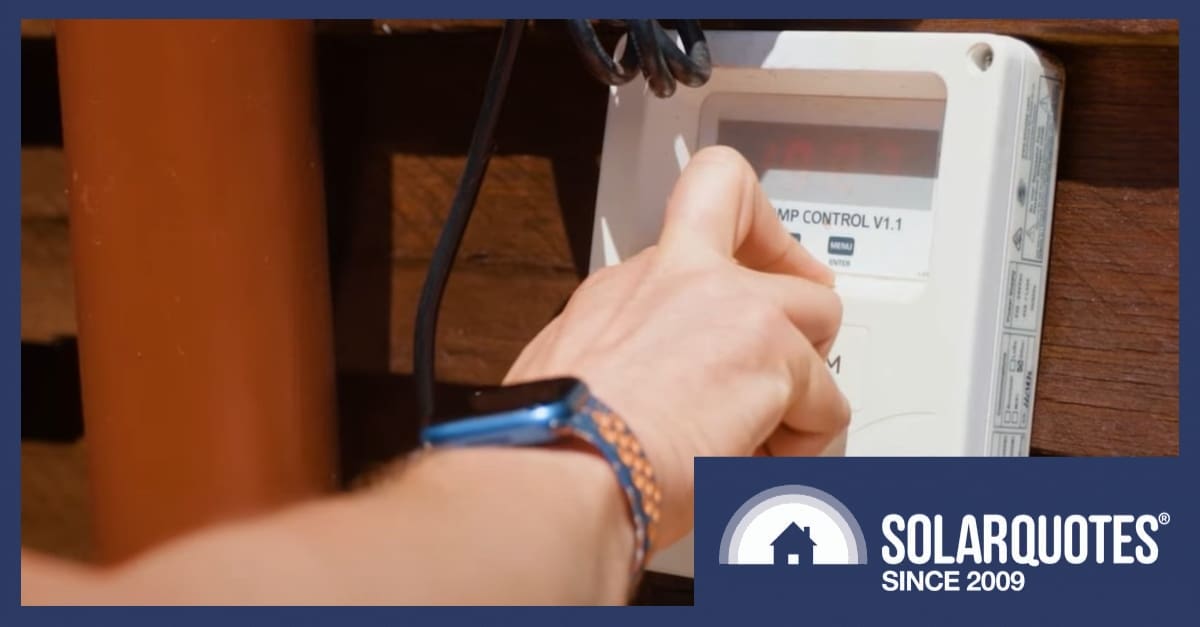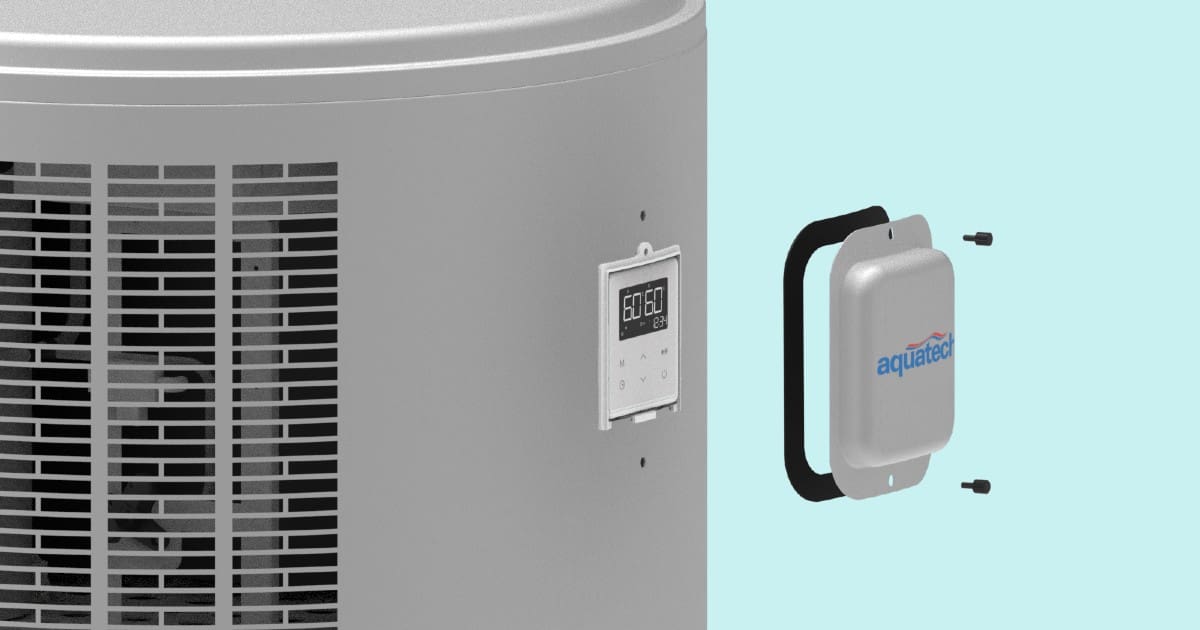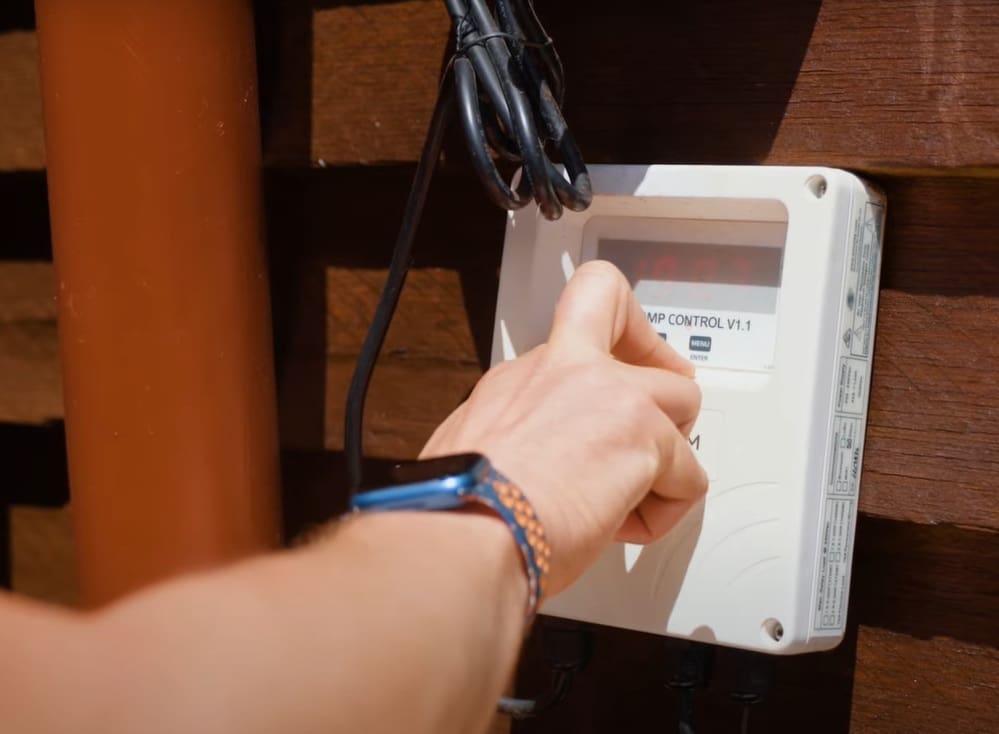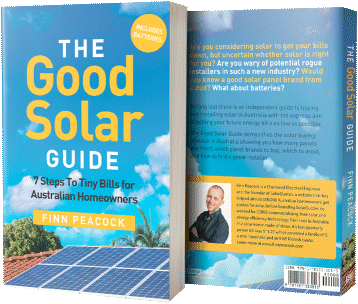 Hot water heat pumps can slash energy bills and carbon emissions due to their sheer efficiency, but take things to another level when timed to draw on cheap solar instead of expensive grid energy. Here’s what your heat pump needs to make this possible.
Hot water heat pumps can slash energy bills and carbon emissions due to their sheer efficiency, but take things to another level when timed to draw on cheap solar instead of expensive grid energy. Here’s what your heat pump needs to make this possible.
How Do You Time Hot Water Heat Pumps To Use Solar?
There are three basic options to consider when choosing a hot water heat pump that works hand-in-glove with rooftop solar: internal timers, external timers, and daytime controlled load circuits. Each offer their own benefits, and can also assist non-solar owners too by ensuring a heat pump runs when electricity is cheapest.
Option 1: A Heat Pump With An Internal Timer
The first option is a timer that can control when the hot water heat pump is on and off. Some heat pumps will have internal timer controls which can offer different time windows for heat pumps to be programmed and operated. Some options include a solar time window during the day to make use of excess solar (i.e. between 9am-3pm) or an off-peak electricity time window to make use of cheaper electricity rates (i.e. between 10pm-7am, this may be preferable for households that don’t have a solar system).

The programmable internal timer of an Aquatech heat pump.
Changing With The Seasons
Certain heat pumps can also give more customized timing options for the users which includes choosing a more specific time window (or different windows) depending on user preference. Moreover, some options can automatically change the timer window based on season, which can be very useful as a household’s hot water requirements, heat pump’s efficiency (often known as Coefficient of Performance – COP), daily energy consumption and the available excess solar generation window can significantly change across seasons. Regardless of these options, you should consider a heat pump manufacturer’s recommendations on the minimum required number of hours per day for heat pumps to run.
I’ve compiled information on heat pump models with and without timers for this piece, drawing on reviews and heat pump manufacturers’ data from manuals and sheets. The first table below is for brands with simple internal timers.
| Heat Pumps With Simple Internal Timers | ||||
|---|---|---|---|---|
| Brand & Model | Programming Ease | Performance | Timer Type | Notes |
| Aquatech X6 | Simple interface | Rated as reliable and straightforward to program. | Basic: Simple digital, multiple periods | Easily adjusts for day vs night loads. |
| Enviroheat 200EH1-14 / 250EH1-15 | Basic onboard | Good for set-and-forget, some DIY confusion reported. | Basic: Single or dual period on/off | Suitable for set-and-forget, less granular. |
| Rinnai Enviroflo | Basic controller menu | Consistent reviews on energy savings. | Basic: Single or dual block | May need installer to help program. |
| Solahart Atmos Eco 280HER | Onboard digital, once learned | Good customer satisfaction. | Basic: Single or dual period | Often set with “solar” default by plumber. |
| Thermann Split | Simple digital, usually set at install | Reliable performance, often “plug & play.” | Basic: Single or dual block | Controller often mounted near tank. |
How To Program An Internal Timer
Internal timers can be programmed by the installers during the installation, left at the default program set by the heat pump manufacturer, or be programmed/changed later by the owners if desired, as some of these timers can easily be controlled by manufacturer apps or LED screens provided on the heat pumps.
Internal Timers Know What The Heat Pump Needs
The advantage of having an internal timer is that you don’t have to buy an external timer to make the most of your solar generation. Furthermore, the internal timer is aware of heat pump operational cycles and wouldn’t turn the unit off during critical operations and cause potential damage or shorten its lifecycle (such as de-frost cycles in colder climates, refrigerant cycles and compressor operation).
| Heat Pumps With Complex Internal Timers | ||||
|---|---|---|---|---|
| Brand & Model | Programming Ease | Performance | Timer Type | Notes |
| Apricus APHP-R290-260 | Easy Wi-Fi app scheduling | Positive user reviews on energy savings & app. | Advanced: Multi-period + Wi-Fi | Digital controller supports multiple time slots, ideal for solar self-use. |
| Emerald All-In-One | Intuitive digital + Wi-Fi | Positive reviews on smart scheduling & quiet operation. | Advanced: Wi-Fi app, multiple schedules | Great for daily or seasonal tweaks. |
| Evoheat EVO150-1 / EVO270-1 / EVO315-C | Advanced touchscreen | Top reviews for energy + solar optimization. | Advanced: Multi-period + optional Wi-Fi module | Allows day split (e.g. 10-3) to maximize solar. |
| Haier Monoblock HP200M1-U1 / HP250M1-U1 | Clear settings | Well-liked for quiet, reliable operation. | Mid: Multi-period digital | Good for daily adjustments. |
| iStore PASHW015-270LD-FL02 | Very clear digital | Excellent ratings on energy bills. | Mid: Digital, supports daily blocks | Easy to tweak to PV export windows. |
| Reclaim CO2 | Often programmed by installer | Widely praised for efficiency & minimal grid use. | Advanced: Multi-period via wall controller | Controller may be tricky DIY, needs plumber to program. |
| Rheem Ambiheat | Digital interface, often set by tradie | Known for reliability & brand trust. | Mid: Multi-period controller | Settings often hidden in installer menu. |
| Sanden SAN-160SAQA / SAN-250SAQA etc | External controller, usually installer set | Leading COP, best for cold climates. | Advanced: Multi-period external | Ideal for complex schedules, but often dealer-only set. |
Option 2: An External Timer
If the heat pump model doesn’t have an internal timer, you can buy an external timer which can control the electrical circuit of the heat pump based on programmed timing windows. The external timer can be a plug-and-play solution, or the timer can also be installed in your switchboard.

An external heat pump timer.
Give The Heat Pump Enough Time To Do Its Job
Like internal timers, external timers give users a programmable time window which can be set to run during solar generation windows, while some units may give options to choose multiple time windows during the day as well. One of the important considerations when using the external timer is to give enough of a time window for the heat pump to complete the operation when heating water, so you are not left without sufficient hot water. Similarly, longer time windows may also reduce the risk of cutting power to a heat pump in the middle of operation. Some installers program external timers on a longer time window to minimize these risks (this can be an easy set & forget solution for some users). On the other hand, longer time windows may potentially reduce utilization of excess solar especially if these time windows cover periods with no or minimal solar.
Less Customisation
Most external timers may not allow detailed customization or seasonal adjustments, and users may manually need to change timer settings if they would like to get more out of their solar across different seasons, depending on their water heating consumption.
External timers will incur additional capital and installation costs however; these are generally not significant. You may get your timer installed during the heat pump installation which can save some money.
| Heat Pumps Without Internal Timers | |||
|---|---|---|---|
| Brand & Model | Performance | External Timer Recommendation | Notes |
| Ecogenica R-series | Highly efficient but lacks internal scheduling, so solar optimization depends on external timer. | Hager EG203E or ABB DBT digital timer. | Needs DIN rail timer to align to solar. |
| Quantum | Reliable heating but always on unless externally controlled. | Clipsal 56 series or ABB DBT recommended. | External Clipsal or Hager timer recommended for solar self-use. |
| Stiebel Eltron WWK 222 / WWK 302 | Quiet operation, efficient but requires external timer for solar. | Clipsal or Hager timer recommended. | Often paired with Hager timer on switchboard. |
Option 3: Controlled Load
Another option to run your heat pump during solar generation window is through controlled load circuits which are managed by the distribution network service providers (DNSPs) or more recently by the retailers (especially in South Australia and New South Wales). Controlled load was traditionally used to run the water heaters in the middle of the night where there wasn’t much demand in the network to keep coal power plants operational. With increasing solar installations and excess generation during the day, controlled load now includes a solar generation window as well, offering cheaper network rates for water heating. This option currently doesn’t allow a household to make use of their own rooftop solar behind their meter but running your heat pump in the middle of the day will indirectly make use of the abundant excess generation in the network.

Putting a heat pump on a controlled load can help save money on your energy bill.
Discounts For The Solar Window
Depending on the retailer, users may get discounted prices for running their appliances during the peak solar generation window. It is a good idea to check with your retailer and ensure their general electricity and controlled load tariffs offer cheaper daytime rates for running their heat pumps.
Potential Damage To Hot Water Heat Pumps
A potential downside with this solution is that heat pump operations may get interrupted in the middle of operations, which may cause potential damage and shorten the life cycle of certain units (not all heat pump manufacturers raise this as a concern however, some do). Also, this solution may not be as financially attractive as the timer solutions, especially if you have your own rooftop solar system.
No Matter What, Understand Your Heat Pump First
No matter which control option you choose, it is extremely helpful to monitor the daily energy operations of your heat pump to understand its operational cycle and power requirements. You may refer to your heat pump manufacturer’s apps or third-party monitoring solutions to do this. This can help you in choosing the optimal solution to make the most of your solar and ensure your heat pump is operating smoothly. It is also important to consider heat pump manufacturer’s recommendations when running your heat pumps on external timers and controlled load to ensure longevity.
Beyond these three options, there are more advanced alternatives to consider, such as configuring your solar inverter to only activate the heat pump when there’s enough solar available, although take care that this doesn’t lead to intermittent turning on and off of the appliance.
For more on hot water heat pumps, browse SolarQuotes’ comparison chart which covers not only whether brands have internal timers, but all the other key specs.
This article was produced in collaboration with Dr. Arastoo Teymouri.

 RSS - Posts
RSS - Posts



I dont make enough solar for 3 months in winter to guarantee enough power for a heat pump, I get my battery charged most days, but not much else.
It would be great if power companies allowed your system to be connected to both your own solar, and the controlled load for when the solar wasn’t enough, but that would make to much sense…
David Taylor. I do love the idea of a heatpump hot water system. However, I have an instantaneous gas system for more than 20 years. I did this to remove the ‘tank’ of water that would usually keep heating up, so wasting power. The new systems have a ‘tank’, so how do I remove that reheating concept? I only use gas for cooking and hot water, and there are just two of us. So, I do not believe I am candidate for the new system. Regards, David
Catch Green will do this. I have the option of solar only, solar with an overnight controlled load top-up, or I can heat straight away using peak power if necessary.
Catch power can be used for resistive loads via both solar and controlled loads. They also have a product catch control which can switch loads. Dont know what size system you have or location, my catch green diverts solar to resistive element and I ditched controlled load, Rarely use mains import for hot water. Geelong Vic. 9.8 kW solar.
There are Hot Water heaters with dual elements. Sparky wires one as controlled load, and one as solar powered (via timer or solar load diverter)
For myself I still believe my solar HWS with a timer which I can over ride and set its boosting function is the most effective system. I set my boost function between 11AM and 3PM daily. It simply allows my heating elements power should the temperature be below the systems hot water settings. So in reality that equates to only drawing power if it needs to and even in winter it often only draws power for less than an hour. Worse scenario is cold weather and no sun for my pvc battery system.
The costs of scrapping a performing solar HWS for a new efficient one together with consideration for impressed pollution ie manufacturing, and disposal etc doesn’t add up no matter how I cut it.
Sure it may be a consideration when the time comes for replacement.
I believe Im getting more solar energy ie from the infared spectrum as an addition to visual light spectrum with both types of collection methods
I agree, KISS principle. We went with HWS with 1.8kW element (did not like the feedback on the heat pumps plus more costs). Set the timer for 930am which suits Winter sun/generation as Summer hot water consumption drops and no biggie as more daylight as well. Timer goes off at 4pm, so ample time to heat for the night even if a cloudy day here in Qld. Our HW power is about 30% of the total, so this is where you get the biggest bang for your buck. Looked at smart switches but could not justify the payback. Time to move the conversation onto the next thing.
There are a LOT of links to methods to control Heat Pumps from Home Assistant. Ideal for the tech savvy or geeks.
Home Assistant can read data from PV equipment (Inverters, batteries, EVs, etc) then can be programmed to control loads such as EV chargers, Heat pumps, A/C´s etc. HA as a total home management solution can monitor &
control the home (even AV equipment), depending on the level one wishes. Many options are already enabled now HA is becoming a more fully featured Open Source solution. Even Bi-directional EV charging management is already included even tho not yet fully available in Australia.
Baran Yildiz: – “A potential downside with this solution is that heat pump operations may get interrupted in the middle of operations, which may cause potential damage and shorten the life cycle of certain units…”
Sanden’s FAQs include:
https://www.sanden-hot-water.com.au/faqs/#faq-10
Thus, for colder climates, some heat pumps on interrupted circuits are not recommended.
What if every one in my family has a bath or a shower is there going to be enough hot water fore every one 7 days a week
You’ll need to make sure you get the right-sized system for your needs.
You could also mention, that heat pumps are more efficient when the ambient temperature is higher (run for less time), so better to run during solar hours from that perspective as well.
Or make life simple and buy a simple electric HWS and run it on a fixed timer for two hours a day between 10 and two utilising your solar electricity. Opportunity cost/KWh varies with FIT (0-12c/KWh on the north coast of NSW). Not many days when a 13.2 KW system won’t produce enough electricity to drive it. Far fewer repairs than a heat pump, no noise, simple installation and $2000 cheaper than a heat pump.
Don’t complicate your life unnecessarily.
A warning: I suggest a Contactor controlled by a timer to switch the HWS, even Heat Pumps. The reason is that some Heat pumps have resistive element backup. There is enough reactance in a circuit to weld simple relays. Contactors do not have this problem.
There is a contactor in the circuit on my board. Protects the timer.
I got a Hydrotherm X8 installed in Sydney for $699 in December 2023, replacing 15 years old electric hot water. It now runs using solar/battery and Free 3 Window, essentially free electricity (because if I don’t have solar I charge my battery with Free 3). It has 6 years full part & labour warranty, just a couple months before Aquatech rebranded the X8 and reduced warranty.
It came with built-in Tuya Smartlife App, so I can do a whole lot of complex schedule without resorting to Home Assistant. It can link with my other sensor and devices. I have a bunch of temp & humidity sensor, AC controller, motion sensor, window & door sensor etc. on Tuya and can then make them do complex automation. E.g. automatically turn on AC within certain time if temp is under X, auto turn off AC if the window is open etc.
Lots of good info here but one concern I have doesnt seem to be addressed. Can all heat pumps cope with external interuptions to power supply and do they come on ok once power is supplied? (As opposed to eg needing the internal clock reset or a start button pressed after power on.) The article addresses possible damage of interupting power mid cycle but does not address other issues with interuptions to external power. We installed some Chromagen Midea 170 litre heat pumps and the clock needs resetting after power interuption.
Jack Gilding: – “Can all heat pumps cope with external interuptions to power supply and do they come on ok once power is supplied?”
I don’t know about hot water heat pumps other than the Sanden brand. The Sanden unit I have has a battery (or is it a supercapacitor?) in their circuitry to keep the clock running accurately and maintain the blockout timer settings when the mains supply circuit is interrupted, at least for a few days. When power has been restored the clock and timer settings haven’t required resetting. The system clock keeps very good time, starting the water reheating cycle just after 10 am (Eastern Standard Time).
Is Catch Power an option for very effective use of solar, without pushing through any production lows through cloudy days ?
It seems like some of the internal timer options might have this, with a timed backup if not enough solar ?
I like the idea of HA with a full tailored option for all production, storage, and usage.
We have a standard tank HWS 250lt, not very old, 3.6kw single element, it’ll probably stay until it drops, then we’ll look at options.
We had it on CL, but recently had it rewired to the main circuit, and a simple analogue timer put in next to the HWS breaker.
With the EV night saver 8c rate, I have found that fine, uses about 40c a day, coming on for about 1.5hrs a night.
If I override the timer during good solar and get it hot after we’ve had the morning shower, it uses just 16c or so from the grid next morning, before the next 24hrs.
Catch Power would have been nice, but $1200 vs the simple timer $360, decided simple, as the battery is coming before next winter.
As I said above, please make sure the sparky has installed a contactor to switch the HWS. Timers eventually weld up & the bills get astronomical!
History: When Enova was running (a Community owned energy reseller sent to receivership by the gentailers) I was a voluntary Energy Coach. I saw many instances of welded contacts on timers directly controlling resistance HWS. Even when the plate rating seems enough (ie 20 or 24A), the reactive spark can still weld the contacts. No problem if the timer switches a contactor.
Consider a smaller element of1.8kW. It will take twice as long to heat the water but will leave you solar capacity for self consumption for laundry and dishwasher use in the day
With ultimate efficiency, upfront costs and long term instal and maintenance costs front of mind.
I ask the number crunchers out there, is it still the case that solar hot water with an electric booster is still the best way to heat water, correct?
That’s not our view
Thanks Max,
Have you got any data where this is spelt out or tested directly?
Have I missed something in the past reporting that you would guide me to?
Regards,
Kel
We’ve done deep dives on hot water options from every angle over the past few years: take a look through our hot water heat pump and solar hot water coverage.
My take on this is 25 yrs ago, I installed a Solar Edwards roof system at home. !0 yrs ago, I installed 2 of resistive HWS in some units I built in Lismore that have 2.4Kw elements, on a timer/contactor which I felt was best option
at the time.
Now, I would agree with Max on Heat pumps, but consider you can use a supplementary hot-fed small HWS powered by PV/Timer/Contactor to reduce lost hot water on long runs in some house designs. (I am currently designing an O/B PassivHaus). btw that is south of Brisvegas!
The reason the roof mounted systems are now not economical is because one needs many trades to do a roof installation, & they can be more expensive to maintain too (I had to re-install my Solar Edwards after a roof replace after Hailstorm.) A heatpump to my knowledge can be installed by a plumber with a connect/disconnect licence for replacement of old ground mount HWS.
https://www.choice.com.au/home-improvement/water/hot-water-systems/articles/gas-vs-electric-hot-water-systems
If you can get access to it this comparison shows clearly that direct heating rooftop solar hw is the most efficient, uses the least energy and the cheapest to run, whether gas boosted or electric. It compares all conventional methods of producing hot water.
Links to their calculations and sources are in the article.
According to Choice magazine, for straight up running costs, yes.
A distinct advantage of resistive HWS (that is little discussed when efficiency is highlighted) is the ability to put the tank immediately next to its most frequent water use,… while wasting heat and water and time while waiting for hot water from a distant but necessary position for the heat pump.
Of course if money is no matter a heat pump can be split with the tank elsewhere,… but is less efficient and much more costly.
Too many times we are conned out of our dough by those who ignore the complete cost of capital, interest and full round trip energy cost including recycling costs, while if we have access to sunshine but do not use it fully we are wasting mg opportunity. There will be times that heat pump is best from economy and efficiency,,… and many times when it is not.
Our pv that is gifted in the middle of the day can be used,..our large pv is better morning and afternoon for our own savings,…so timing is important,…but bigger pv is always better
Past retirement age and living in Victoria in the Ausnet power zone with solar panels (6.6kw) and an old fashioned hot water heater that turns on at midnight (11pm in daylight savings time) via a controlled load pulse. I fully understand the options that are available (eg heat pump, switchboard timer etc) but the simplest and cheapest for myself would be if Ausnet or the retailer would send the pulse at a time better suited to solar. This I am told by Ausnet and the retailer is not possible!
Some options to make use of the solar:
-CatchPower timer is one answer, maybe $1000 if I am lucky
-Heat pump anywhere from $1000 to $5000 depending on quality
-Start a campaign for a change in Victoria to controlled load timing
Many thanks for all that great info. Looks like I will get stuck into some research, and technical info.
My dilemma is, that tank. Mass storage, heating up and cooling down.
Yes I will do some research, thanks for the feedback
Thanks Brian,
I did look at choice but didn’t see that, well done.
The anode is the only ongoing maintenance for the Solar Hot water tank every 3-5 years, we don’t use the electric booster often due to high solar location and a big tank. (14 years ongoing)
So in our case SHW is by far superior.
Kel,
With your system installed 14 years ago. I agree that at the time that was the best option. However, the reality now is that roof mounted HW hardware wastes valuable PV Kws of space. Also water needs to be plumbed up that costs more than a ground mounted tank.
If I was building now, I would use a Heat Pump. Just buy a good quality with 10 yrs warranty. The small amount of power (5>6 Kw/day? for frugal family) is well offset by the 2>3Kw of extra panels that can also help charge an EV!
Maintenance is much easier & cheaper on a Ground mounted HWS.
ps: I was, at one time, A Choice tester…..